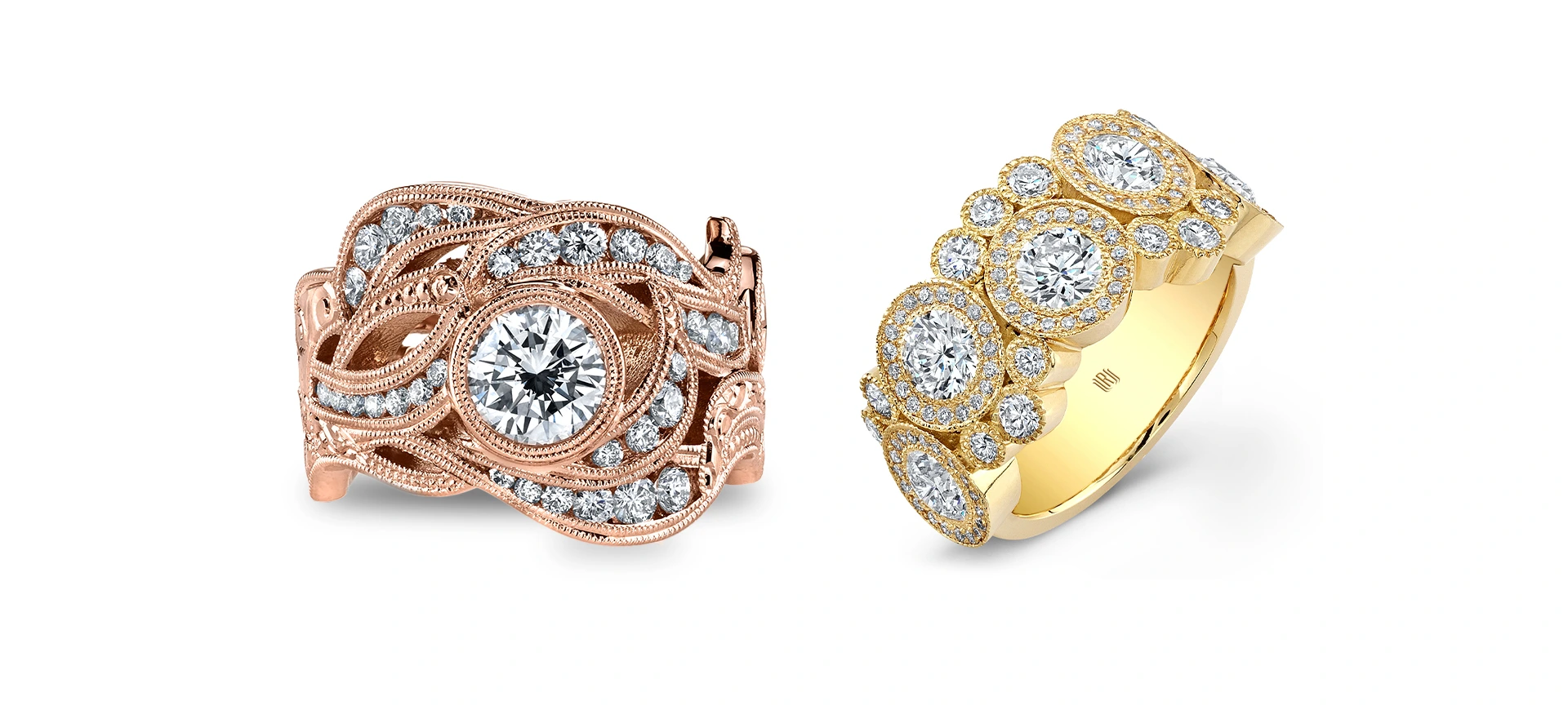Courtesy: (left) evelynH. Jewelry Inc. and (right) Rahaminov Diamonds
The ring on the left features rose gold and round brilliant diamonds, the ring on the right features 18K yellow gold set with round brilliant diamonds.
Every detail within a jewelry piece can showcase your style and exquisite taste, including precious metals. Yellow gold and rose gold are two beloved metal options, each bringing individual charm and character to the table. Let’s explore the distinctive qualities and visual differences between yellow and rose gold. Then, you can confidently pick which metal best suits your personality and purpose when purchasing jewelry.
What is Yellow Gold?
Gold is a timeless precious metal known for its rich, warm hue, enduring beauty and its resistance to tarnishing. Because gold is soft, the yellow gold used in jewelry is usually composed of pure gold alloyed with other metals, such as copper and silver, to enhance durability and strength. Widely used for all types of jewelry—from classic engagement ring sets to trendy necklace designs—the enduring appeal of yellow gold makes it a cherished choice for both traditional and contemporary pieces.
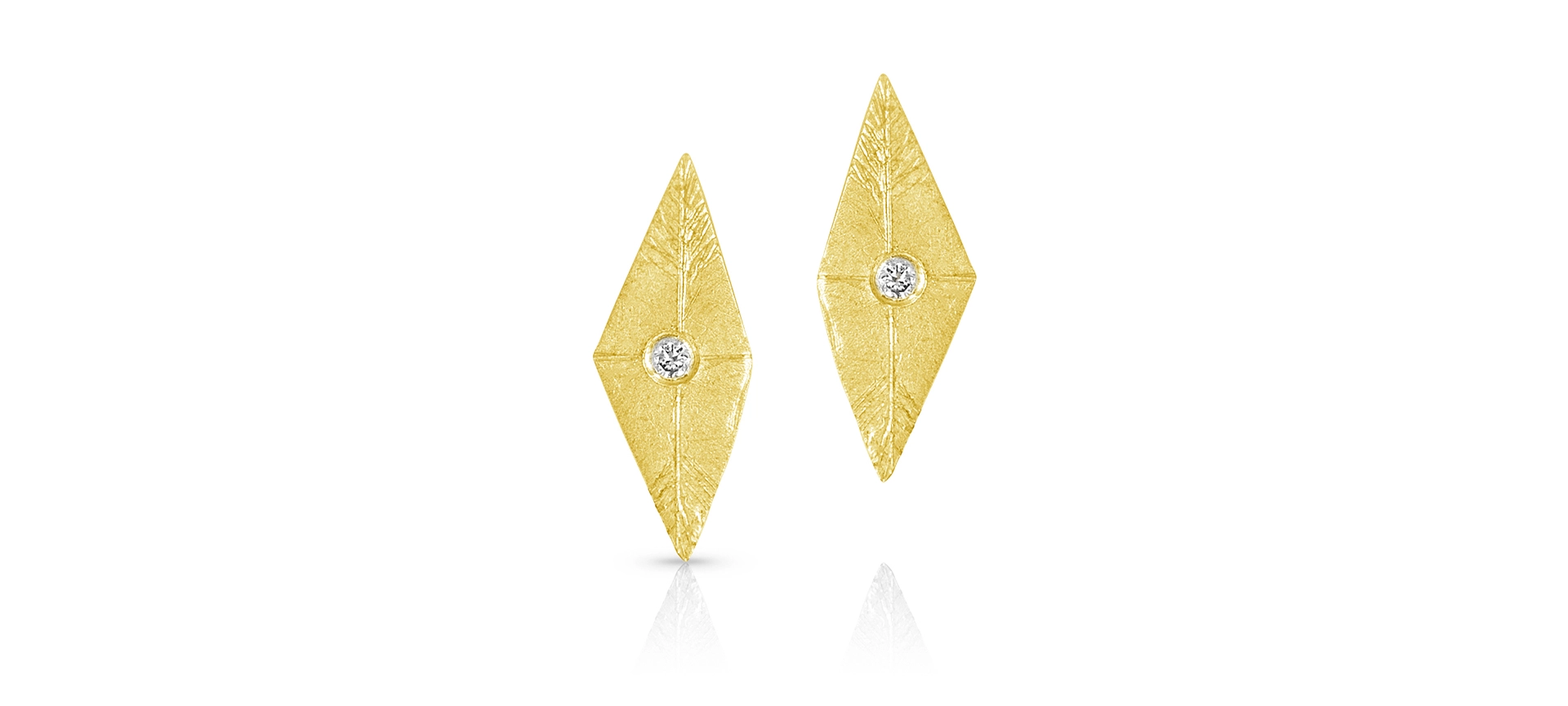
Kite-shaped stud earrings with textured surface made from 14K recycled gold and set with 1mm flush-set Canadamark diamonds.
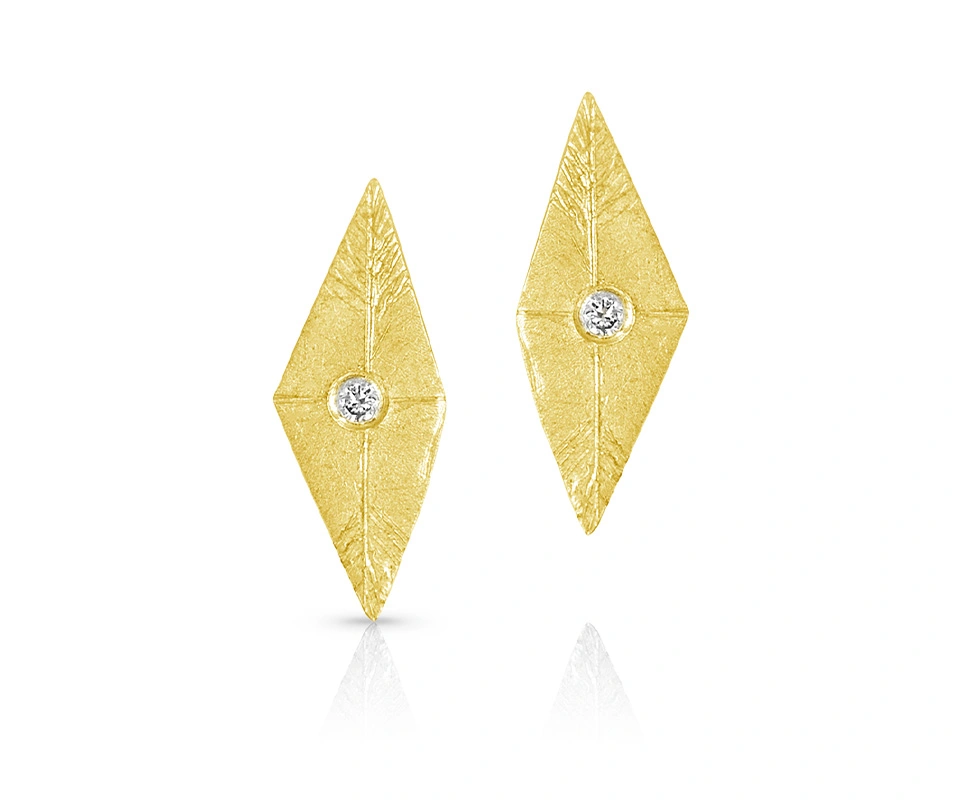
Kite-shaped stud earrings with textured surface made from 14K recycled gold and set with 1mm flush-set Canadamark diamonds.
Yellow Gold Karat Composition and Color
Gold’s purity is measured in karats, with 24 karats indicating pure gold. For practical purposes, pure gold is often alloyed with other metals like copper and zinc to enhance its hardness. The mixtures create options like 22K gold, 18K gold and 14K gold. The precise combination of alloyed metals to pure gold determines the shade of yellow gold, ranging from a bright, vibrant yellow to a deeper, more subtle tone—generally, the purer the gold, the more “yellow” the color.
| Types of Yellow Gold | Yellow Gold Composition |
|---|---|
| 24K Gold (Pure Gold) | Contains 100% Gold |
| 22K Gold | 92% Gold and 8% Alloyed Metals |
| 18K Gold | 75% Gold and 25% Alloyed Metals |
| 14K Gold | 58% Gold and 42% Alloyed Metals |
History of Yellow Gold
Yellow gold holds a storied history steeped in tradition and prestige dating back to ancient civilizations such as Egypt and Rome. These cultures revered gold for its rarity, durability and beauty, using it to craft exquisite jewelry pieces and ceremonial artifacts. Over the centuries, yellow gold has symbolized wealth, power and luxury, becoming synonymous with opulence.
Yellow Gold’s Versatility
The versatility of yellow gold further contributes to its enduring popularity. It complements various gemstones, from fiery, brilliant-cut diamonds to the vibrant hues of sapphires and emeralds. Additionally, its malleability allows artisans to craft intricate designs and elaborate patterns, such as Victorian-style filigree or custom etchings.
What is Rose Gold?
Rose gold is a romantic metal renowned for its delicate pink coloring and elegant charm. Its gorgeous color is achieved by mixing pure gold with copper—and sometimes silver—to create a stunning blush-toned metal. The proportion of copper to pure gold determines the intensity of the pink coloring, ranging from barely-there to can’t-miss.
However, rose gold’s appeal isn’t all about aesthetics. As pure gold is relatively soft, adding harder metals like copper and silver enhances the strength and durability of the piece. Ultimately, rose gold’s stunning look and practical allure have cemented its place in fine jewelry.
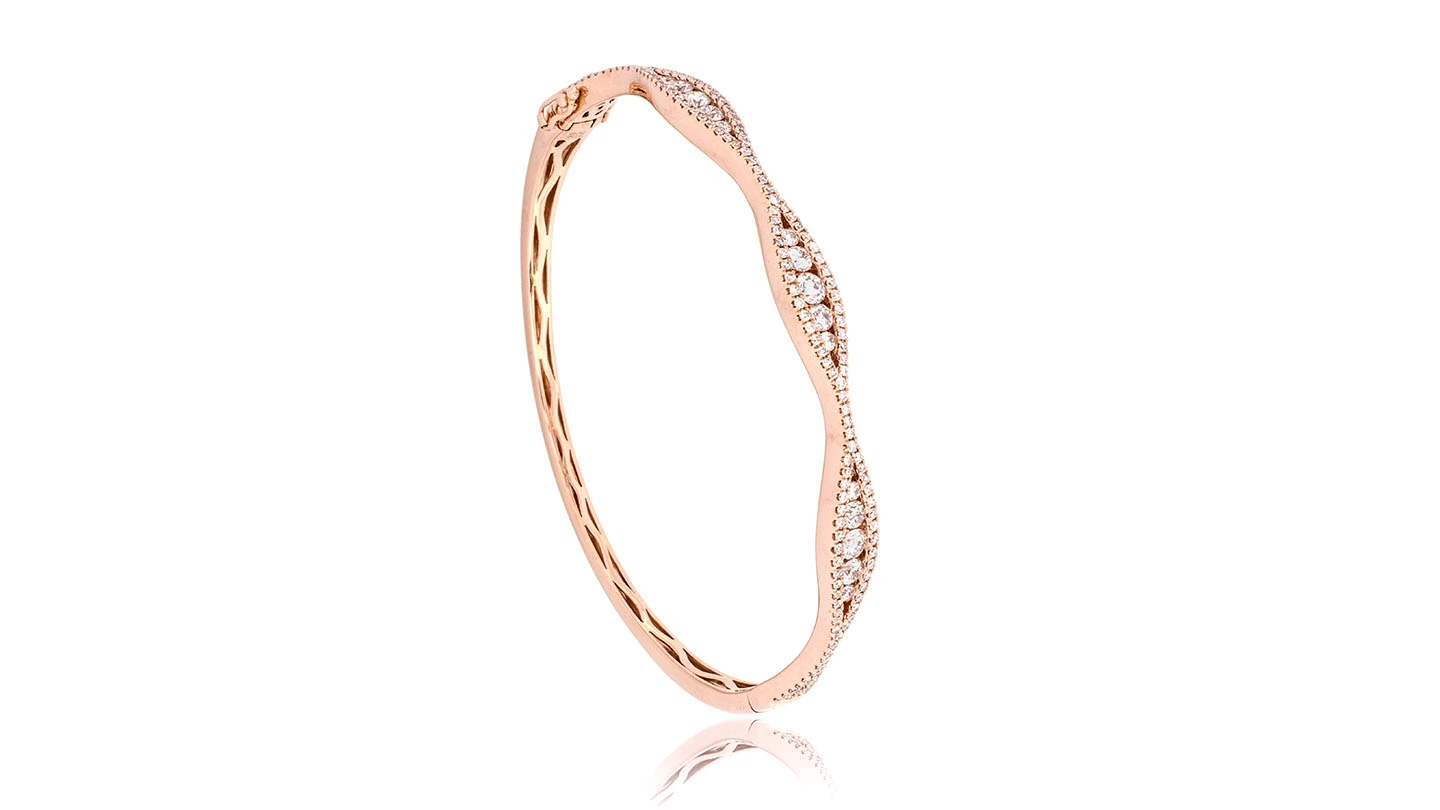
Simple and elegant, this 14k rose gold bangle showcases a ripple design adorned with 1.43 carats of sparkling diamonds—perfect for adding a touch of luxury to any look.
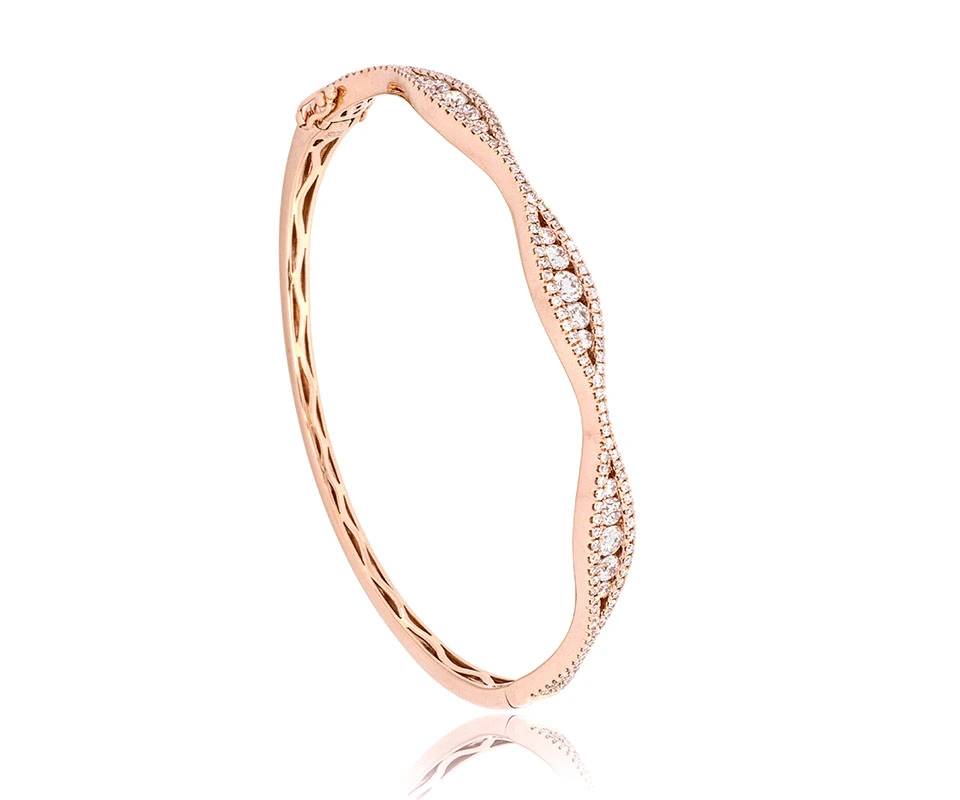
Simple and elegant, this 14k rose gold bangle showcases a ripple design adorned with 1.43 carats of sparkling diamonds—perfect for adding a touch of luxury to any look.
Rose Gold Karat Composition and Color
The distinctive blush of rose gold is achieved through a careful blend of pure gold with copper alloys. The higher the copper content, the more pronounced the pinkish hue.
| Types of Rose Gold | Common Rose Gold Compositions |
|---|---|
| 22K Rose Gold | 91.7% Gold, 0% Silver, 8.4% Copper |
| 18K Rose Gold | 75% Gold, 9.2% Silver, 22.2% Copper |
| 14K Rose Gold | 58.3% Gold, 9.2% Silver, 32.5% Copper |
| 10K Rose Gold | 41.7% Gold, 20% Silver, 38.3% Copper |
| 9K Rose Gold | 37.5% Gold, 20% Silver, 42.5% Copper |
History of Rose Gold
The enchanting history of rose gold begins during the Romantic Era of the early 19th century, characterized by a revival of art, literature and sentimentality. As the Industrial Revolution swept across Europe, advancements in metal science allowed artisans to experiment with new alloys and colors, including rose gold.
Initially known as “Russian gold” or “pink gold,” the term “rose gold” gained popularity for its floral and feminine feel. Carl Fabergé famously utilized rose gold in his intricate Fabergé eggs, which became coveted treasures of the Russian Imperial Court. From there, the love for rose gold expanded across the globe and became the symbol of love and sophistication it is today.
Modern Appeal of Rose Gold
Rose gold remains a stylish choice for those seeking a standout piece of jewelry. From minimalist to avant-garde necklace statement pieces, rose gold offers endless possibilities for self-expression.
It’s also a metal that complements a variety of gems—from the brilliant sparkle of diamonds to the vivid allure of brilliantly colored gemstones. Rose gold has become synonymous with versatility and individuality.
Yellow Gold vs. Rose Gold Differences
Durability and Tarnish
Yellow Gold
Yellow gold is softer than other types of gold, making it more prone to scratches, dings and damage. The lower the karat, the more durable the jewelry will be. However, while pure gold doesn’t tarnish, the alloys within gold jewelry can tarnish. The lower the karat, the more susceptible the jewelry is to tarnishing. With proper care, however, a well-crafted yellow-gold piece of any karat can withstand the rigors of everyday wear and retain its sparkling shine for a long time.
Rose Gold
Due to its copper content, rose gold is stronger and more durable than yellow gold of the same karat. However, a lower karat yellow gold such as 10K is more durable than 18K rose gold. The copper in rose gold can develop a charming patina over time. This natural aging process can add depth, individuality, and character to every piece.
Price and Value
Yellow Gold
Yellow gold has a long-standing tradition in jewelry. Often associated with luxury, royalty and prestige, its historical significance adds to its value. Including mixed alloys like silver and copper can influence its color and price. The demand for yellow gold jewelry can fluctuate based on market trends and cultural preferences, affecting costs accordingly.
Rose Gold
Rose gold jewelry has become popular during modern times for its romantic pink hue and because it flatters a variety of skin tones. Its price is typically the same as yellow gold with the same karat purity. High-end jewelry most often uses 18K gold, with 14K and 10K rose or yellow gold costing less. Depending on its mix of alloys, rose gold can come in a range of pinkish hues. Rose gold with lower karat will often have a stronger pink color due to its higher copper content.
Allergies and Skin Sensitivities
Yellow Gold
While allergic reactions are less common with yellow gold than other metals, it is still good to be aware of the possibility. Yellow gold is typically alloyed with metals such as copper and silver, which can occasionally trigger allergies in individuals with sensitivities to these metals. To reduce the risk of allergic reactions, consider higher-purity gold options or inquire about hypoallergenic alternatives with a GIA-approved jeweler. Always communicate any metal allergies or sensitivities with your jeweler to ensure you select safe and suitable jewelry for your skin.
Rose Gold
Like yellow gold, rose gold is less likely than other metals to trigger an allergic reaction. That said, the copper in rose gold may cause reactions in some wearers with metal sensitivities. To minimize the risk of allergic responses, explore higher purity rose gold options or discuss hypoallergenic alternatives with your jeweler. Be sure to communicate any metal allergies or sensitivities with your jeweler to ensure your jewelry is safe and compatible with your skin.
Ongoing Maintenance
Yellow Gold
Regularly clean your yellow gold jewelry with diluted dishsoap and water. Use a soft cloth or brush to remove dirt or debris from prongs and crevices. This will help your yellow gold pieces retain their exquisite luster.
Rose Gold
Similarly, rose gold requires routine cleaning using a soft cloth or brush with diluted dishsoap and water. This helps prevent any buildup of dirt or oils that may affect its appearance, allowing rose gold jewelry to maintain its radiant glow and charm.
With proper care and maintenance, yellow gold and rose gold jewelry can be loved and cherished for generations.
Yellow Gold vs. Rose Gold: How to Choose the Best Metal for Your Jewelry
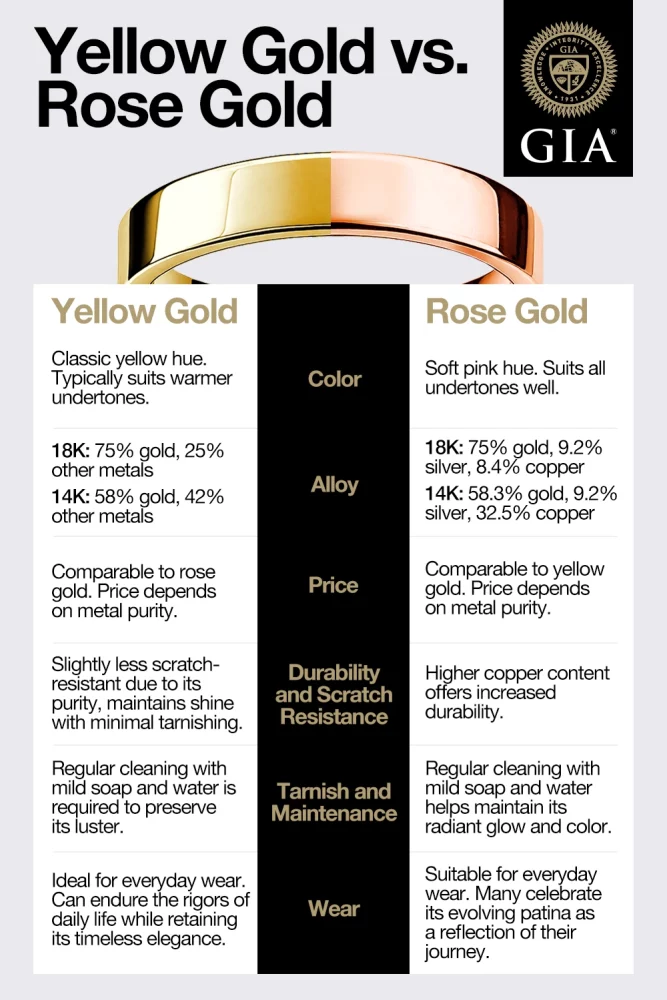
Yellow Gold vs. Rose Gold FAQs
What Skin Tones Look Best With Rose Gold?
Rose gold complements a wide range of skin tones. Its warm and rosy hue has a neutralizing effect, enhancing the natural beauty of people of all complexions.
What Skin Tones Look Best With Yellow Gold?
Yellow gold best suits those with yellow or warmer undertones by amplifying the wearer’s natural glow.
What is the Symbolism of Yellow Gold and Rose Gold?
Yellow gold symbolizes wealth, tradition and luxury. Rose gold signifies love, femininity and modernity.
Can You Wear Rose Gold and Yellow Gold Together?
Yes! Mixing rose gold and yellow gold—such as in a ring stack—can create a stylish and eclectic look that adds depth to your look and allows for next-level creative expression.
Is Rose Gold Actually Gold?
Yes. Rose gold is a gold alloy made of gold, copper and sometimes silver. This gives it a distinctive pinkish hue that differentiates it from traditional yellow gold and other popular metals.
Is Rose Gold Good for Engagement Rings or Wedding Rings?
Rose gold is an excellent option for engagement rings due to its durability and romantic appeal. It offers an incredible way to express love and commitment to your significant other.
Next Steps for Designing Your Ring: Choosing Your Diamond
Now that you’re ready to decide between rose gold vs. yellow gold (or both!), explore which diamonds can perfectly complement your new piece of jewelry. Start your journey by understanding a diamond’s value through the 4Cs—cut, color, clarity and carat weight, the diamond grading system established by GIA. Empower yourself with the knowledge to make informed decisions and find a spectacular diamond to adorn your preferred metal.
Why Trust GIA to Find Your Perfect Jewelry or Ring?
The Gemological Institute of America (GIA) is a renowned authority in gemology and jewelry education. GIA offers unbiased, expert knowledge, diamond and gemstone reports, and research to assist consumers in making informed decisions. With GIA’s trusted insights, you can confidently approach your jewelry purchase, knowing you’re selecting the ideal metal for your needs and preferences.
